Online Library for Study Material | Desklib
VerifiedAdded on 2023/06/04
|13
|2312
|156
AI Summary
Desklib is an online library for study material with solved assignments, essays, dissertations, and more. It offers a vast collection of study material for various subjects and courses. The article includes answers to accounting questions, benefits of operational budget, cost analysis, and balance scorecard.
Contribute Materials
Your contribution can guide someone’s learning journey. Share your
documents today.
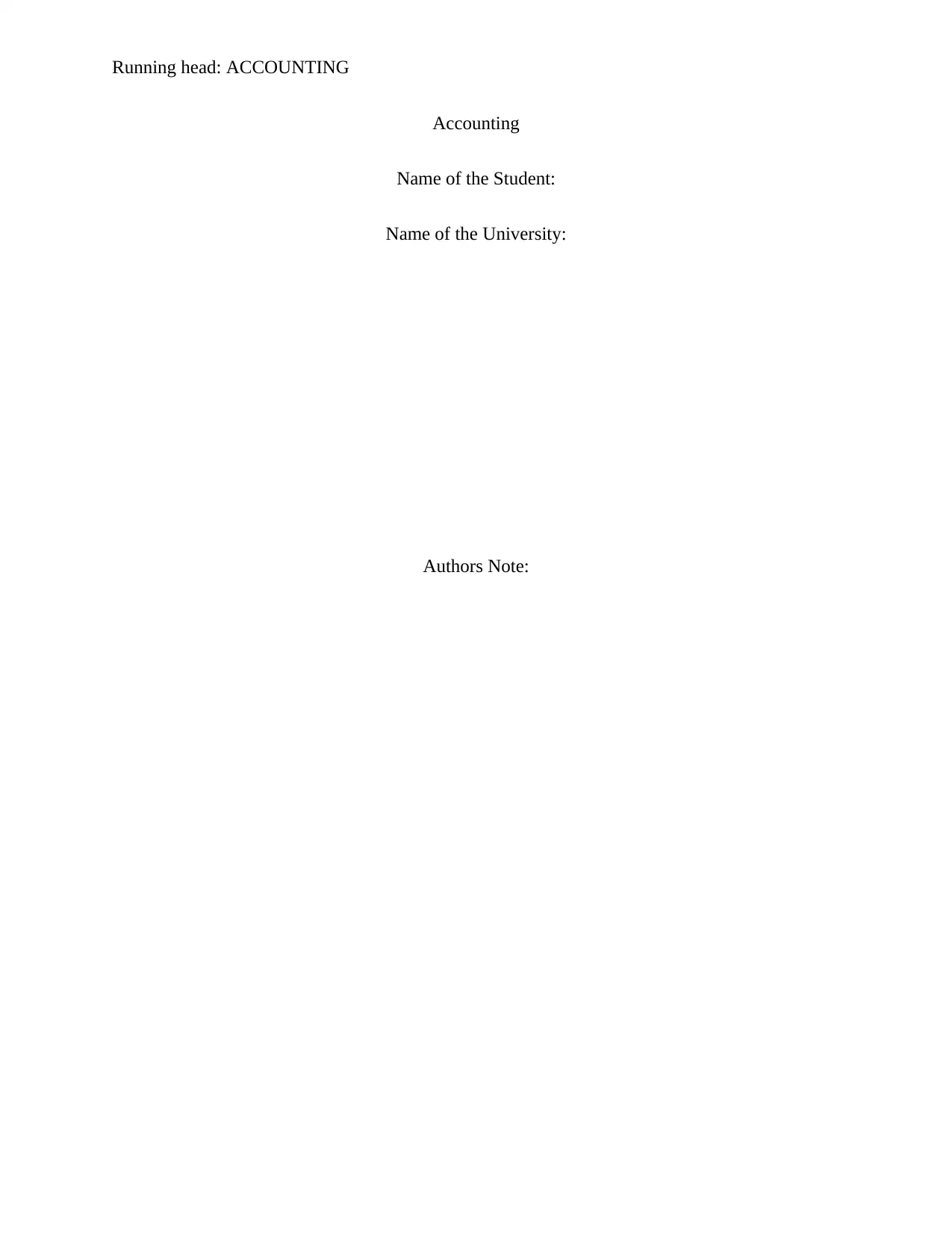
Running head: ACCOUNTING
Accounting
Name of the Student:
Name of the University:
Authors Note:
Accounting
Name of the Student:
Name of the University:
Authors Note:
Secure Best Marks with AI Grader
Need help grading? Try our AI Grader for instant feedback on your assignments.
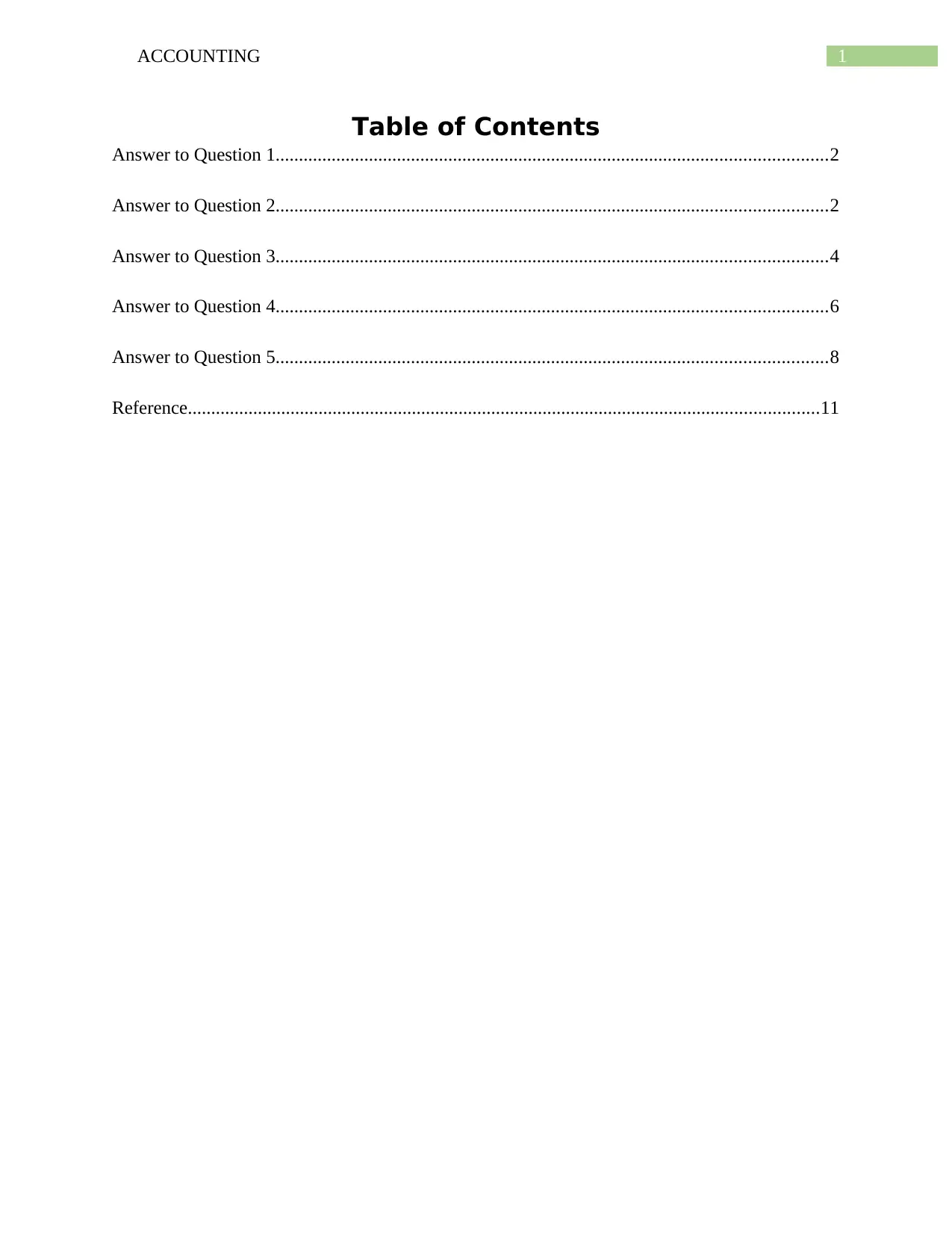
1ACCOUNTING
Table of Contents
Answer to Question 1......................................................................................................................2
Answer to Question 2......................................................................................................................2
Answer to Question 3......................................................................................................................4
Answer to Question 4......................................................................................................................6
Answer to Question 5......................................................................................................................8
Reference.......................................................................................................................................11
Table of Contents
Answer to Question 1......................................................................................................................2
Answer to Question 2......................................................................................................................2
Answer to Question 3......................................................................................................................4
Answer to Question 4......................................................................................................................6
Answer to Question 5......................................................................................................................8
Reference.......................................................................................................................................11
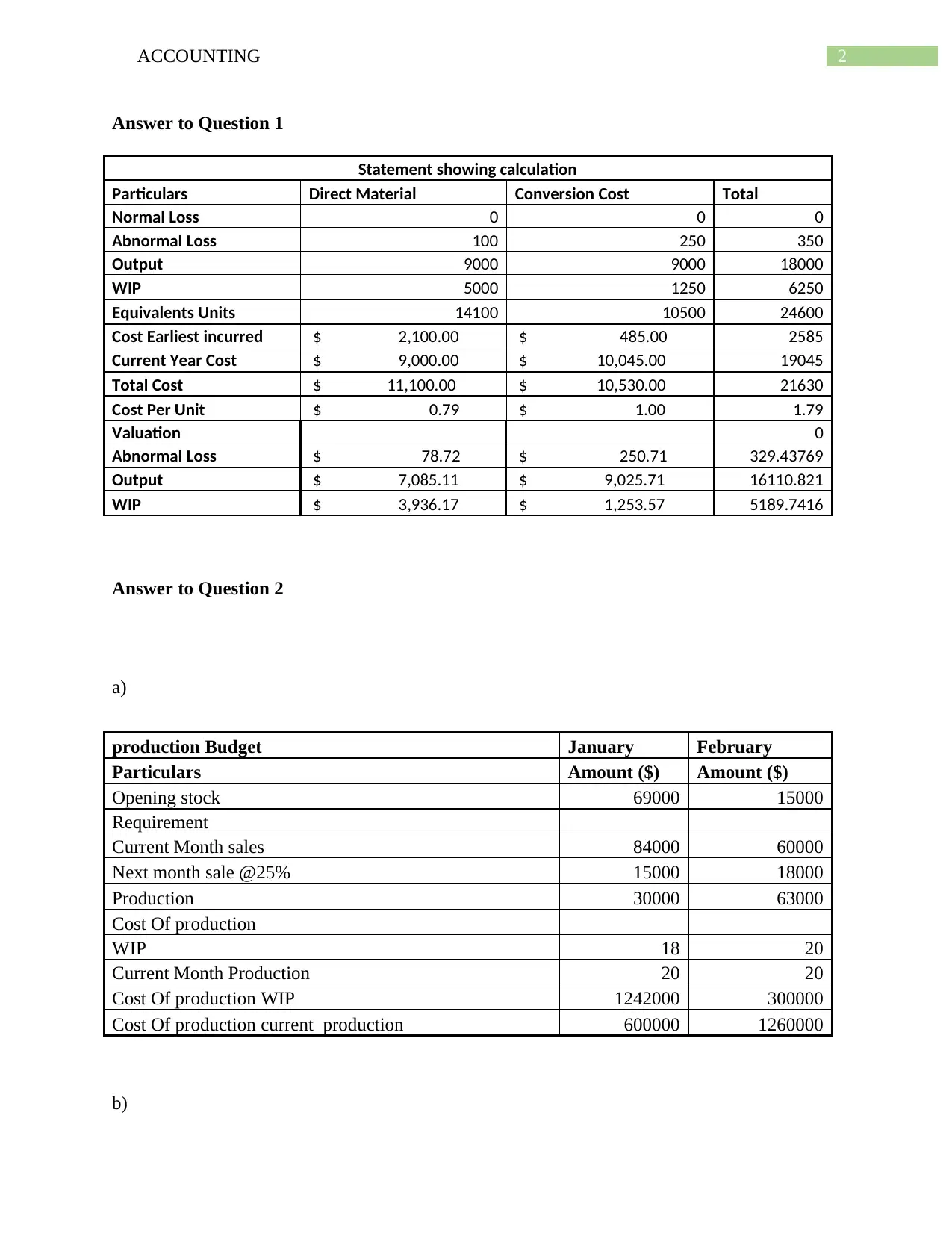
2ACCOUNTING
Answer to Question 1
Statement showing calculation
Particulars Direct Material Conversion Cost Total
Normal Loss 0 0 0
Abnormal Loss 100 250 350
Output 9000 9000 18000
WIP 5000 1250 6250
Equivalents Units 14100 10500 24600
Cost Earliest incurred $ 2,100.00 $ 485.00 2585
Current Year Cost $ 9,000.00 $ 10,045.00 19045
Total Cost $ 11,100.00 $ 10,530.00 21630
Cost Per Unit $ 0.79 $ 1.00 1.79
Valuation 0
Abnormal Loss $ 78.72 $ 250.71 329.43769
Output $ 7,085.11 $ 9,025.71 16110.821
WIP $ 3,936.17 $ 1,253.57 5189.7416
Answer to Question 2
a)
production Budget January February
Particulars Amount ($) Amount ($)
Opening stock 69000 15000
Requirement
Current Month sales 84000 60000
Next month sale @25% 15000 18000
Production 30000 63000
Cost Of production
WIP 18 20
Current Month Production 20 20
Cost Of production WIP 1242000 300000
Cost Of production current production 600000 1260000
b)
Answer to Question 1
Statement showing calculation
Particulars Direct Material Conversion Cost Total
Normal Loss 0 0 0
Abnormal Loss 100 250 350
Output 9000 9000 18000
WIP 5000 1250 6250
Equivalents Units 14100 10500 24600
Cost Earliest incurred $ 2,100.00 $ 485.00 2585
Current Year Cost $ 9,000.00 $ 10,045.00 19045
Total Cost $ 11,100.00 $ 10,530.00 21630
Cost Per Unit $ 0.79 $ 1.00 1.79
Valuation 0
Abnormal Loss $ 78.72 $ 250.71 329.43769
Output $ 7,085.11 $ 9,025.71 16110.821
WIP $ 3,936.17 $ 1,253.57 5189.7416
Answer to Question 2
a)
production Budget January February
Particulars Amount ($) Amount ($)
Opening stock 69000 15000
Requirement
Current Month sales 84000 60000
Next month sale @25% 15000 18000
Production 30000 63000
Cost Of production
WIP 18 20
Current Month Production 20 20
Cost Of production WIP 1242000 300000
Cost Of production current production 600000 1260000
b)
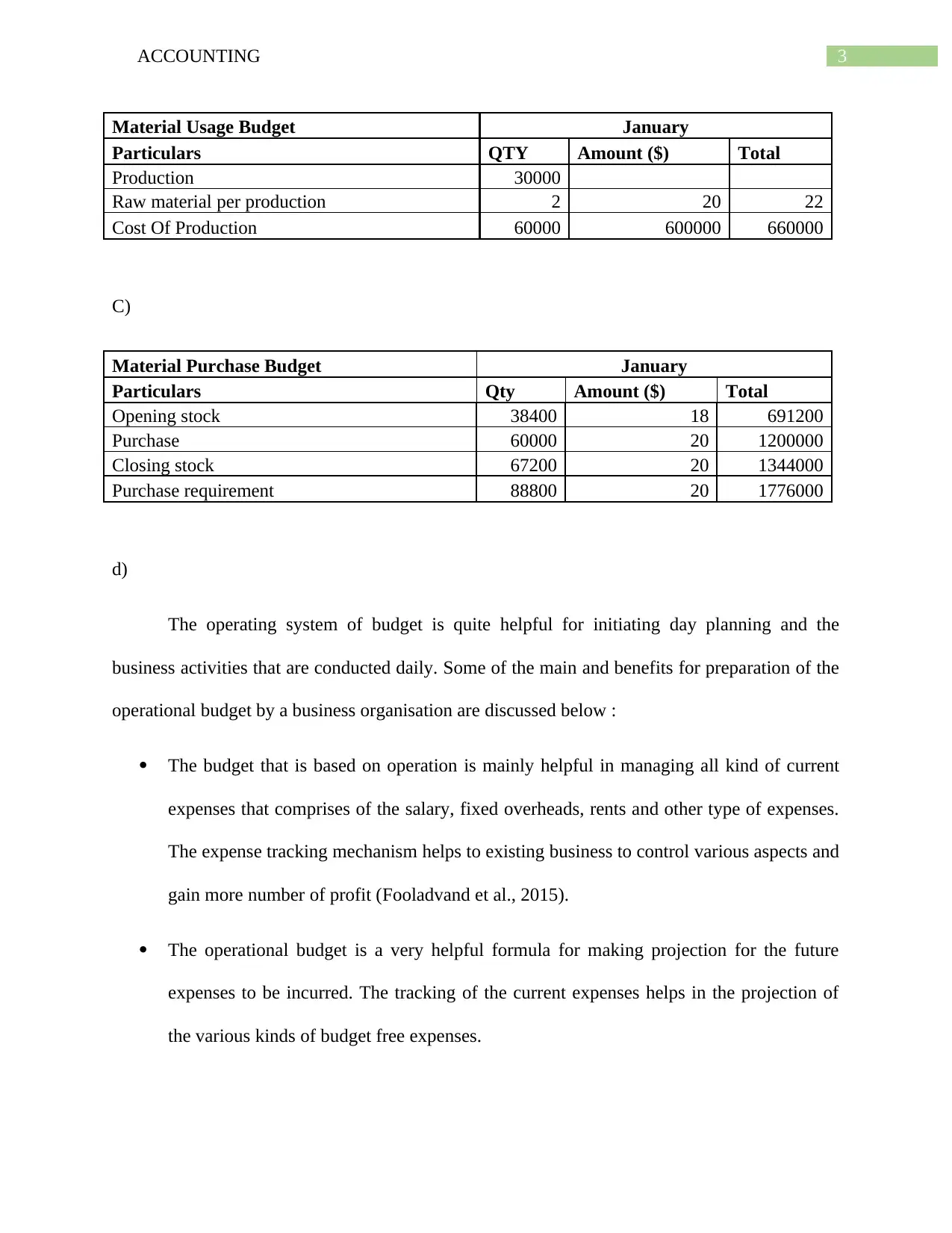
3ACCOUNTING
Material Usage Budget January
Particulars QTY Amount ($) Total
Production 30000
Raw material per production 2 20 22
Cost Of Production 60000 600000 660000
C)
Material Purchase Budget January
Particulars Qty Amount ($) Total
Opening stock 38400 18 691200
Purchase 60000 20 1200000
Closing stock 67200 20 1344000
Purchase requirement 88800 20 1776000
d)
The operating system of budget is quite helpful for initiating day planning and the
business activities that are conducted daily. Some of the main and benefits for preparation of the
operational budget by a business organisation are discussed below :
The budget that is based on operation is mainly helpful in managing all kind of current
expenses that comprises of the salary, fixed overheads, rents and other type of expenses.
The expense tracking mechanism helps to existing business to control various aspects and
gain more number of profit (Fooladvand et al., 2015).
The operational budget is a very helpful formula for making projection for the future
expenses to be incurred. The tracking of the current expenses helps in the projection of
the various kinds of budget free expenses.
Material Usage Budget January
Particulars QTY Amount ($) Total
Production 30000
Raw material per production 2 20 22
Cost Of Production 60000 600000 660000
C)
Material Purchase Budget January
Particulars Qty Amount ($) Total
Opening stock 38400 18 691200
Purchase 60000 20 1200000
Closing stock 67200 20 1344000
Purchase requirement 88800 20 1776000
d)
The operating system of budget is quite helpful for initiating day planning and the
business activities that are conducted daily. Some of the main and benefits for preparation of the
operational budget by a business organisation are discussed below :
The budget that is based on operation is mainly helpful in managing all kind of current
expenses that comprises of the salary, fixed overheads, rents and other type of expenses.
The expense tracking mechanism helps to existing business to control various aspects and
gain more number of profit (Fooladvand et al., 2015).
The operational budget is a very helpful formula for making projection for the future
expenses to be incurred. The tracking of the current expenses helps in the projection of
the various kinds of budget free expenses.
Secure Best Marks with AI Grader
Need help grading? Try our AI Grader for instant feedback on your assignments.
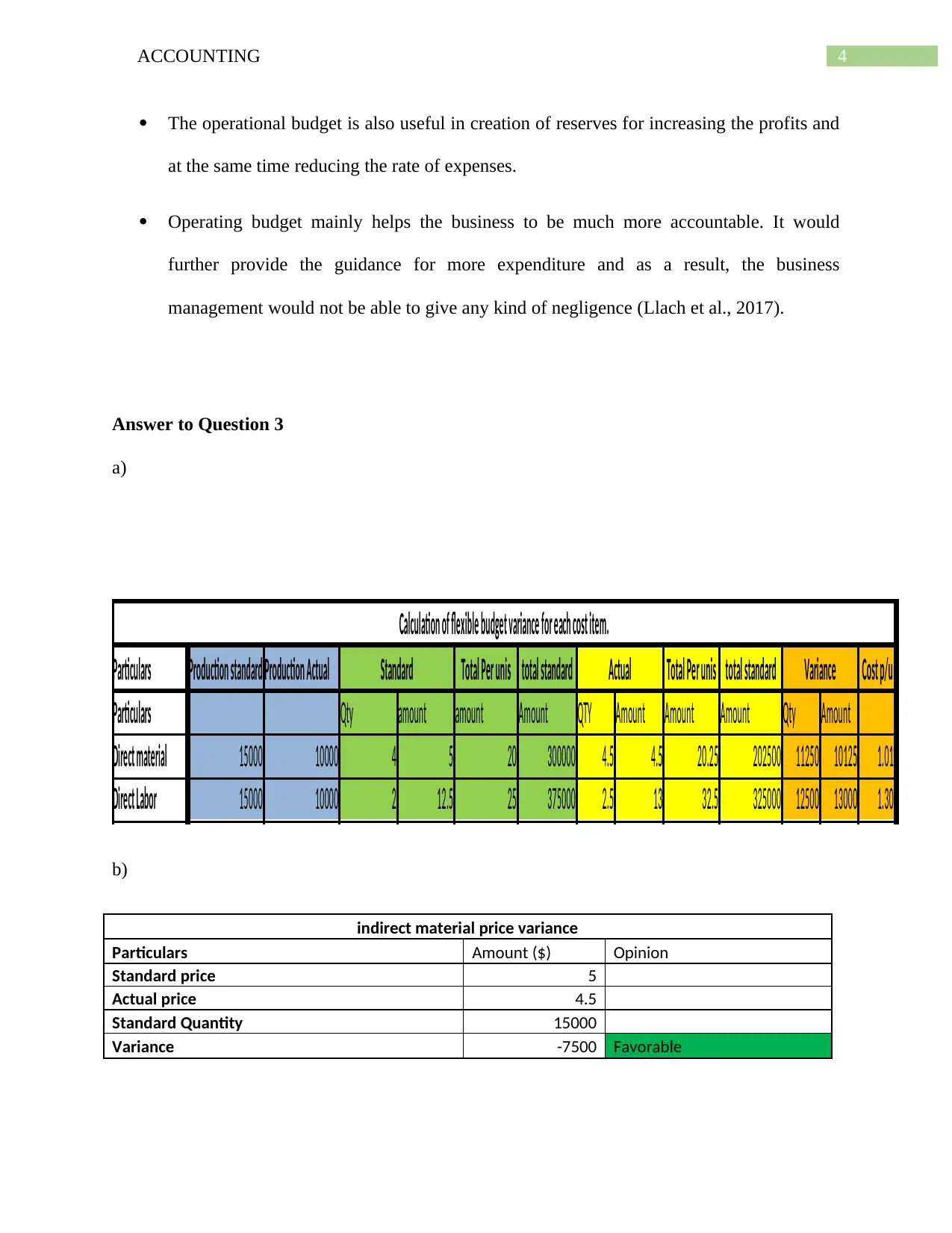
4ACCOUNTING
The operational budget is also useful in creation of reserves for increasing the profits and
at the same time reducing the rate of expenses.
Operating budget mainly helps the business to be much more accountable. It would
further provide the guidance for more expenditure and as a result, the business
management would not be able to give any kind of negligence (Llach et al., 2017).
Answer to Question 3
a)
Calculation of flexible budget variance for each cost item.
Particulars Production standard Production Actual Standard Total Per unis total standard Actual Total Per unis total standard Variance Cost p/u
Particulars Qty amount amount Amount QTY Amount Amount Amount Qty Amount
Direct material 15000 10000 4 5 20 300000 4.5 4.5 20.25 202500 11250 10125 1.01
Direct Labor 15000 10000 2 12.5 25 375000 2.5 13 32.5 325000 12500 13000 1.30
b)
indirect material price variance
Particulars Amount ($) Opinion
Standard price 5
Actual price 4.5
Standard Quantity 15000
Variance -7500 Favorable
The operational budget is also useful in creation of reserves for increasing the profits and
at the same time reducing the rate of expenses.
Operating budget mainly helps the business to be much more accountable. It would
further provide the guidance for more expenditure and as a result, the business
management would not be able to give any kind of negligence (Llach et al., 2017).
Answer to Question 3
a)
Calculation of flexible budget variance for each cost item.
Particulars Production standard Production Actual Standard Total Per unis total standard Actual Total Per unis total standard Variance Cost p/u
Particulars Qty amount amount Amount QTY Amount Amount Amount Qty Amount
Direct material 15000 10000 4 5 20 300000 4.5 4.5 20.25 202500 11250 10125 1.01
Direct Labor 15000 10000 2 12.5 25 375000 2.5 13 32.5 325000 12500 13000 1.30
b)
indirect material price variance
Particulars Amount ($) Opinion
Standard price 5
Actual price 4.5
Standard Quantity 15000
Variance -7500 Favorable
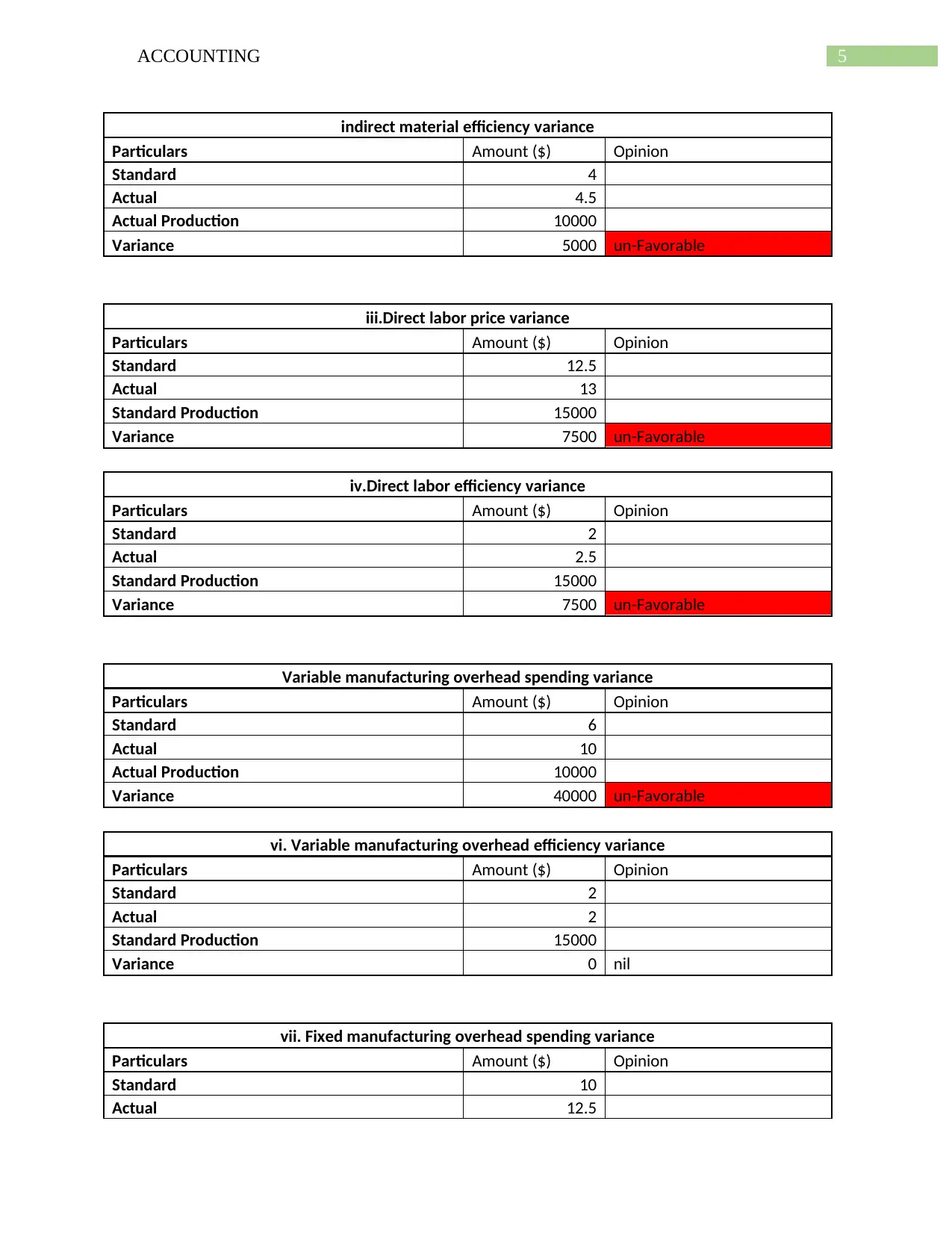
5ACCOUNTING
indirect material efficiency variance
Particulars Amount ($) Opinion
Standard 4
Actual 4.5
Actual Production 10000
Variance 5000 un-Favorable
iii.Direct labor price variance
Particulars Amount ($) Opinion
Standard 12.5
Actual 13
Standard Production 15000
Variance 7500 un-Favorable
iv.Direct labor efficiency variance
Particulars Amount ($) Opinion
Standard 2
Actual 2.5
Standard Production 15000
Variance 7500 un-Favorable
Variable manufacturing overhead spending variance
Particulars Amount ($) Opinion
Standard 6
Actual 10
Actual Production 10000
Variance 40000 un-Favorable
vi. Variable manufacturing overhead efficiency variance
Particulars Amount ($) Opinion
Standard 2
Actual 2
Standard Production 15000
Variance 0 nil
vii. Fixed manufacturing overhead spending variance
Particulars Amount ($) Opinion
Standard 10
Actual 12.5
indirect material efficiency variance
Particulars Amount ($) Opinion
Standard 4
Actual 4.5
Actual Production 10000
Variance 5000 un-Favorable
iii.Direct labor price variance
Particulars Amount ($) Opinion
Standard 12.5
Actual 13
Standard Production 15000
Variance 7500 un-Favorable
iv.Direct labor efficiency variance
Particulars Amount ($) Opinion
Standard 2
Actual 2.5
Standard Production 15000
Variance 7500 un-Favorable
Variable manufacturing overhead spending variance
Particulars Amount ($) Opinion
Standard 6
Actual 10
Actual Production 10000
Variance 40000 un-Favorable
vi. Variable manufacturing overhead efficiency variance
Particulars Amount ($) Opinion
Standard 2
Actual 2
Standard Production 15000
Variance 0 nil
vii. Fixed manufacturing overhead spending variance
Particulars Amount ($) Opinion
Standard 10
Actual 12.5

6ACCOUNTING
Actual Production 10000
Variance 25000 un-Favorable
viii. Fixed manufacturing overhead spending variance
Particulars Amount ($) Opinion
Standard 2
Actual 2
Standard Production 10000
Variance 0 nil
Answer to Question 4
a)
Calculation of cost per unit 4000 units
Particulars Amount ($) Amount ($) Amount ($) Amount ($)
Selling Price 500 2000000
Variable Cost
Direct material 100 400000
Direct Labor 50 200000
Manufacturing Support 90 360000
Marketing Cost 35 140000
Total Variable Cost 275 0 1100000
Fixed Cost
manufacturing cost 115 460000
Marketing Cost 40 160000
Total Fixed Cost 155 620000
Total Cost Per Unit 430 1720000
Profit 70 280000
b)
Customer Offering
Calculation of cost per unit 4000 units
Actual Production 10000
Variance 25000 un-Favorable
viii. Fixed manufacturing overhead spending variance
Particulars Amount ($) Opinion
Standard 2
Actual 2
Standard Production 10000
Variance 0 nil
Answer to Question 4
a)
Calculation of cost per unit 4000 units
Particulars Amount ($) Amount ($) Amount ($) Amount ($)
Selling Price 500 2000000
Variable Cost
Direct material 100 400000
Direct Labor 50 200000
Manufacturing Support 90 360000
Marketing Cost 35 140000
Total Variable Cost 275 0 1100000
Fixed Cost
manufacturing cost 115 460000
Marketing Cost 40 160000
Total Fixed Cost 155 620000
Total Cost Per Unit 430 1720000
Profit 70 280000
b)
Customer Offering
Calculation of cost per unit 4000 units
Paraphrase This Document
Need a fresh take? Get an instant paraphrase of this document with our AI Paraphraser
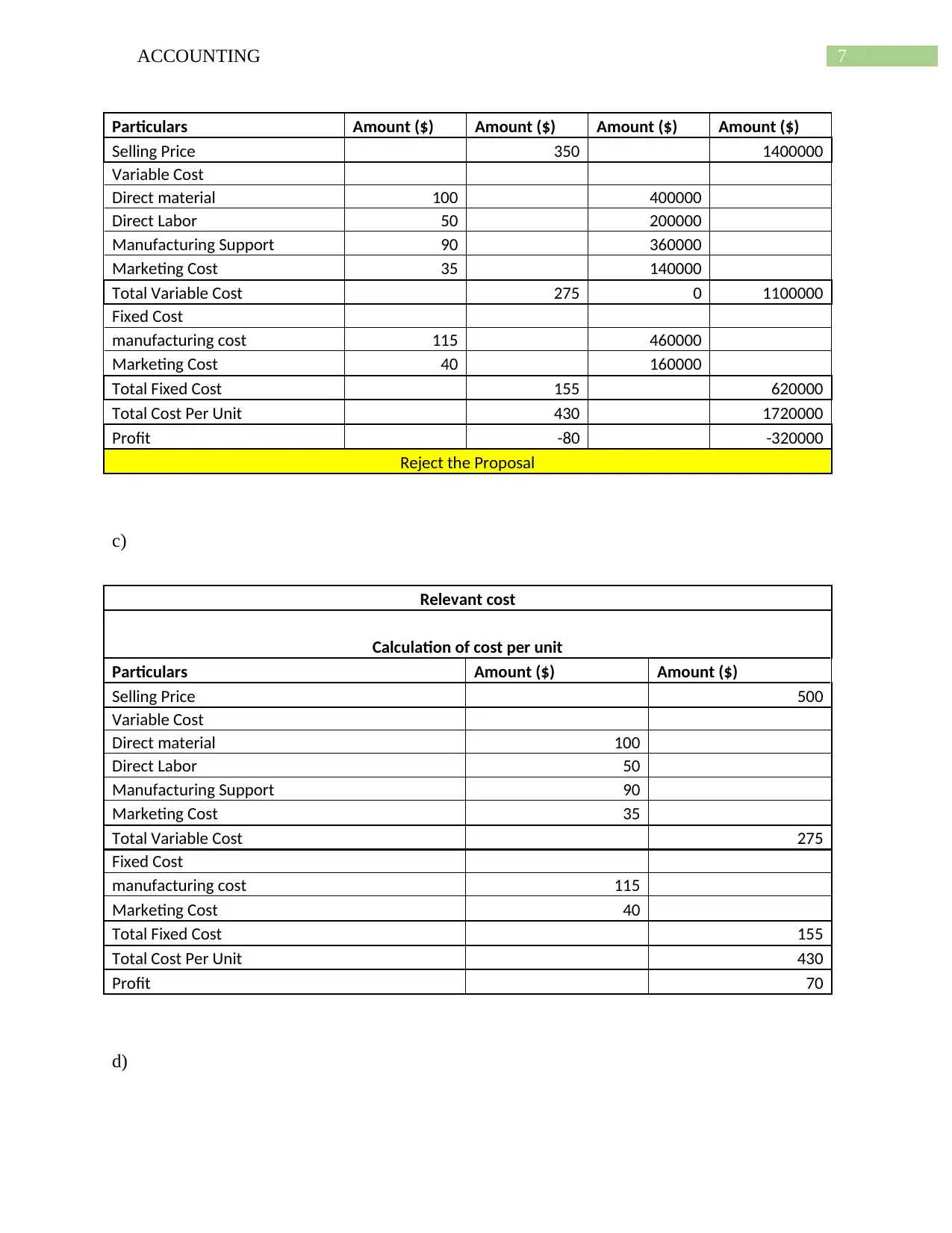
7ACCOUNTING
Particulars Amount ($) Amount ($) Amount ($) Amount ($)
Selling Price 350 1400000
Variable Cost
Direct material 100 400000
Direct Labor 50 200000
Manufacturing Support 90 360000
Marketing Cost 35 140000
Total Variable Cost 275 0 1100000
Fixed Cost
manufacturing cost 115 460000
Marketing Cost 40 160000
Total Fixed Cost 155 620000
Total Cost Per Unit 430 1720000
Profit -80 -320000
Reject the Proposal
c)
Relevant cost
Calculation of cost per unit
Particulars Amount ($) Amount ($)
Selling Price 500
Variable Cost
Direct material 100
Direct Labor 50
Manufacturing Support 90
Marketing Cost 35
Total Variable Cost 275
Fixed Cost
manufacturing cost 115
Marketing Cost 40
Total Fixed Cost 155
Total Cost Per Unit 430
Profit 70
d)
Particulars Amount ($) Amount ($) Amount ($) Amount ($)
Selling Price 350 1400000
Variable Cost
Direct material 100 400000
Direct Labor 50 200000
Manufacturing Support 90 360000
Marketing Cost 35 140000
Total Variable Cost 275 0 1100000
Fixed Cost
manufacturing cost 115 460000
Marketing Cost 40 160000
Total Fixed Cost 155 620000
Total Cost Per Unit 430 1720000
Profit -80 -320000
Reject the Proposal
c)
Relevant cost
Calculation of cost per unit
Particulars Amount ($) Amount ($)
Selling Price 500
Variable Cost
Direct material 100
Direct Labor 50
Manufacturing Support 90
Marketing Cost 35
Total Variable Cost 275
Fixed Cost
manufacturing cost 115
Marketing Cost 40
Total Fixed Cost 155
Total Cost Per Unit 430
Profit 70
d)
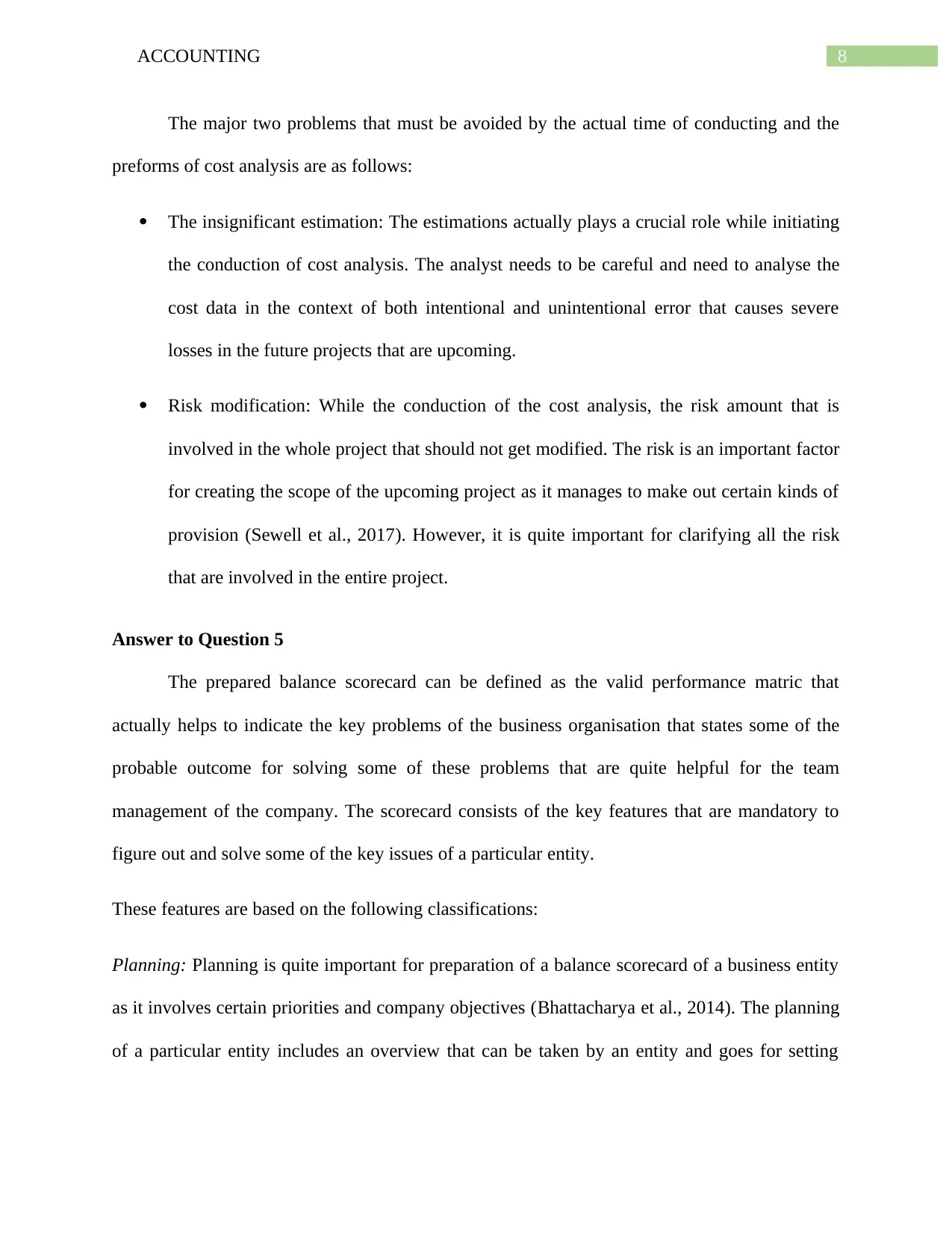
8ACCOUNTING
The major two problems that must be avoided by the actual time of conducting and the
preforms of cost analysis are as follows:
The insignificant estimation: The estimations actually plays a crucial role while initiating
the conduction of cost analysis. The analyst needs to be careful and need to analyse the
cost data in the context of both intentional and unintentional error that causes severe
losses in the future projects that are upcoming.
Risk modification: While the conduction of the cost analysis, the risk amount that is
involved in the whole project that should not get modified. The risk is an important factor
for creating the scope of the upcoming project as it manages to make out certain kinds of
provision (Sewell et al., 2017). However, it is quite important for clarifying all the risk
that are involved in the entire project.
Answer to Question 5
The prepared balance scorecard can be defined as the valid performance matric that
actually helps to indicate the key problems of the business organisation that states some of the
probable outcome for solving some of these problems that are quite helpful for the team
management of the company. The scorecard consists of the key features that are mandatory to
figure out and solve some of the key issues of a particular entity.
These features are based on the following classifications:
Planning: Planning is quite important for preparation of a balance scorecard of a business entity
as it involves certain priorities and company objectives (Bhattacharya et al., 2014). The planning
of a particular entity includes an overview that can be taken by an entity and goes for setting
The major two problems that must be avoided by the actual time of conducting and the
preforms of cost analysis are as follows:
The insignificant estimation: The estimations actually plays a crucial role while initiating
the conduction of cost analysis. The analyst needs to be careful and need to analyse the
cost data in the context of both intentional and unintentional error that causes severe
losses in the future projects that are upcoming.
Risk modification: While the conduction of the cost analysis, the risk amount that is
involved in the whole project that should not get modified. The risk is an important factor
for creating the scope of the upcoming project as it manages to make out certain kinds of
provision (Sewell et al., 2017). However, it is quite important for clarifying all the risk
that are involved in the entire project.
Answer to Question 5
The prepared balance scorecard can be defined as the valid performance matric that
actually helps to indicate the key problems of the business organisation that states some of the
probable outcome for solving some of these problems that are quite helpful for the team
management of the company. The scorecard consists of the key features that are mandatory to
figure out and solve some of the key issues of a particular entity.
These features are based on the following classifications:
Planning: Planning is quite important for preparation of a balance scorecard of a business entity
as it involves certain priorities and company objectives (Bhattacharya et al., 2014). The planning
of a particular entity includes an overview that can be taken by an entity and goes for setting

9ACCOUNTING
some of the objectives along with some principles that fixes a specific path for operation within
the business entity.
Performance Targets: The concept of performance targets within an entity determines the
outcomes that is expected and must exist after a specific time period. The strategies used are
quite flexible in terms of any changes in the behaviour of the company stakeholders. All the
strategies must be developed is such critical situations. All the strategies work as particular
guidance of the company’s management for carrying out some business in specific line or a
specific pathway (Wouters & Kirchberger, 2015).
Predictions: The predictions are very important for making an ideal balance scorecard. There are
certain kinds of changes that can seriously occur in certain time period of a particular time. The
predictions consist of the risk and the changes in the nature of the market. It can be also related
to the stakeholders or any such issues regarding operations or profit making. This can also
threaten the business properties and thus some of the criterion must be maintained. Predictions
also help the company management to prepare certain kinds of provision for securing the entity
from the upcoming the upcoming threats that occurs in the business operational period.
Management can even be prepared for those issues.
Motivation: For some of the far-reaching goals and predictions by the company’s management, it
is quite important to keep the entire employee base remained motivated for increasing the work
productivity as well as the efficiency. The workflow of the business entity can be maintained
through this way (van Helden & Uddin, 2016). This is probably the only possible reason why the
structure needs to be pre-planned for initiating an operation for employee motivation that is a
fundamental condition in balance score card. In this particular section, the sessions, the training,
incentives along with some other facilities by whose evaluation an employee can be rewarded or
some of the objectives along with some principles that fixes a specific path for operation within
the business entity.
Performance Targets: The concept of performance targets within an entity determines the
outcomes that is expected and must exist after a specific time period. The strategies used are
quite flexible in terms of any changes in the behaviour of the company stakeholders. All the
strategies must be developed is such critical situations. All the strategies work as particular
guidance of the company’s management for carrying out some business in specific line or a
specific pathway (Wouters & Kirchberger, 2015).
Predictions: The predictions are very important for making an ideal balance scorecard. There are
certain kinds of changes that can seriously occur in certain time period of a particular time. The
predictions consist of the risk and the changes in the nature of the market. It can be also related
to the stakeholders or any such issues regarding operations or profit making. This can also
threaten the business properties and thus some of the criterion must be maintained. Predictions
also help the company management to prepare certain kinds of provision for securing the entity
from the upcoming the upcoming threats that occurs in the business operational period.
Management can even be prepared for those issues.
Motivation: For some of the far-reaching goals and predictions by the company’s management, it
is quite important to keep the entire employee base remained motivated for increasing the work
productivity as well as the efficiency. The workflow of the business entity can be maintained
through this way (van Helden & Uddin, 2016). This is probably the only possible reason why the
structure needs to be pre-planned for initiating an operation for employee motivation that is a
fundamental condition in balance score card. In this particular section, the sessions, the training,
incentives along with some other facilities by whose evaluation an employee can be rewarded or
Secure Best Marks with AI Grader
Need help grading? Try our AI Grader for instant feedback on your assignments.
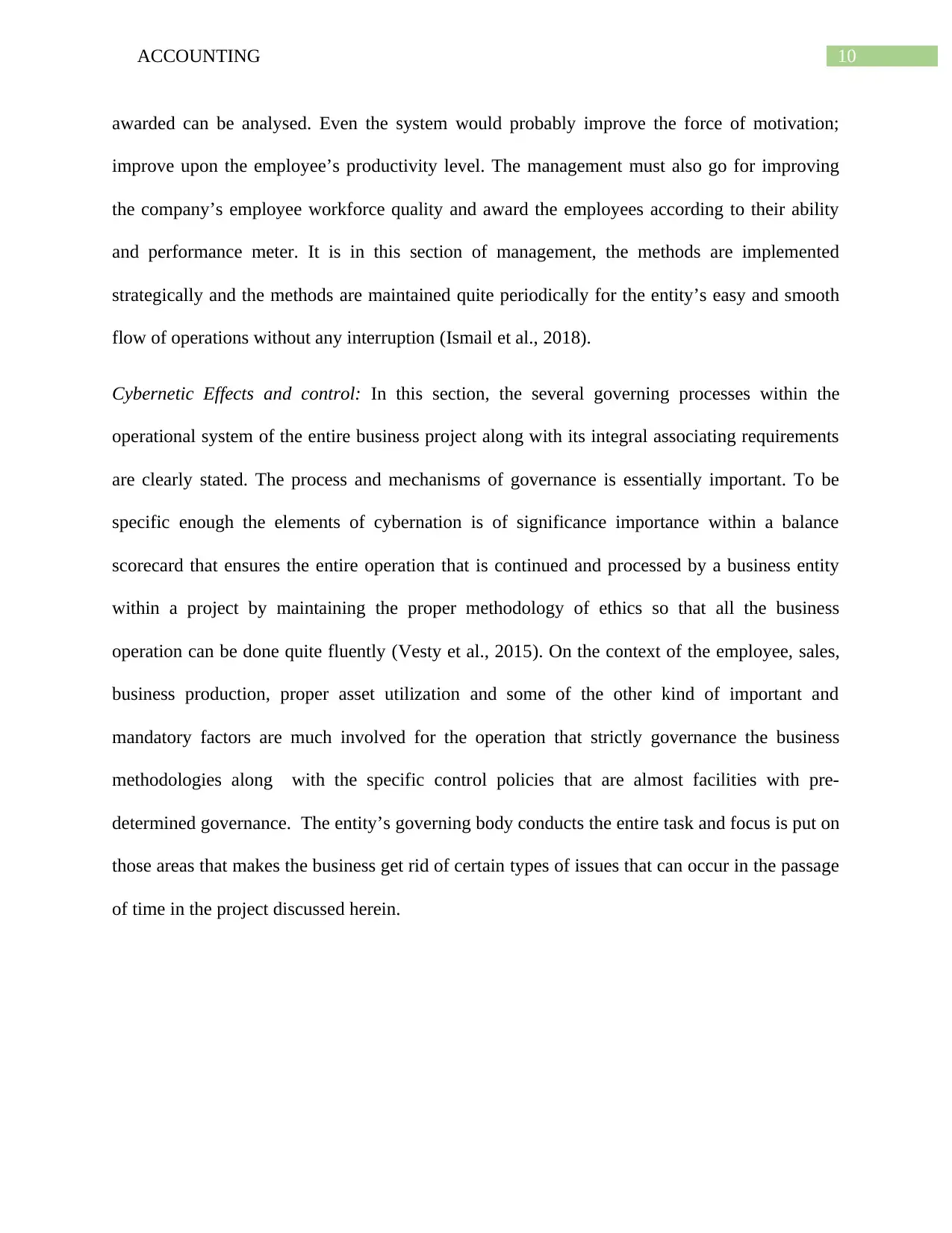
10ACCOUNTING
awarded can be analysed. Even the system would probably improve the force of motivation;
improve upon the employee’s productivity level. The management must also go for improving
the company’s employee workforce quality and award the employees according to their ability
and performance meter. It is in this section of management, the methods are implemented
strategically and the methods are maintained quite periodically for the entity’s easy and smooth
flow of operations without any interruption (Ismail et al., 2018).
Cybernetic Effects and control: In this section, the several governing processes within the
operational system of the entire business project along with its integral associating requirements
are clearly stated. The process and mechanisms of governance is essentially important. To be
specific enough the elements of cybernation is of significance importance within a balance
scorecard that ensures the entire operation that is continued and processed by a business entity
within a project by maintaining the proper methodology of ethics so that all the business
operation can be done quite fluently (Vesty et al., 2015). On the context of the employee, sales,
business production, proper asset utilization and some of the other kind of important and
mandatory factors are much involved for the operation that strictly governance the business
methodologies along with the specific control policies that are almost facilities with pre-
determined governance. The entity’s governing body conducts the entire task and focus is put on
those areas that makes the business get rid of certain types of issues that can occur in the passage
of time in the project discussed herein.
awarded can be analysed. Even the system would probably improve the force of motivation;
improve upon the employee’s productivity level. The management must also go for improving
the company’s employee workforce quality and award the employees according to their ability
and performance meter. It is in this section of management, the methods are implemented
strategically and the methods are maintained quite periodically for the entity’s easy and smooth
flow of operations without any interruption (Ismail et al., 2018).
Cybernetic Effects and control: In this section, the several governing processes within the
operational system of the entire business project along with its integral associating requirements
are clearly stated. The process and mechanisms of governance is essentially important. To be
specific enough the elements of cybernation is of significance importance within a balance
scorecard that ensures the entire operation that is continued and processed by a business entity
within a project by maintaining the proper methodology of ethics so that all the business
operation can be done quite fluently (Vesty et al., 2015). On the context of the employee, sales,
business production, proper asset utilization and some of the other kind of important and
mandatory factors are much involved for the operation that strictly governance the business
methodologies along with the specific control policies that are almost facilities with pre-
determined governance. The entity’s governing body conducts the entire task and focus is put on
those areas that makes the business get rid of certain types of issues that can occur in the passage
of time in the project discussed herein.
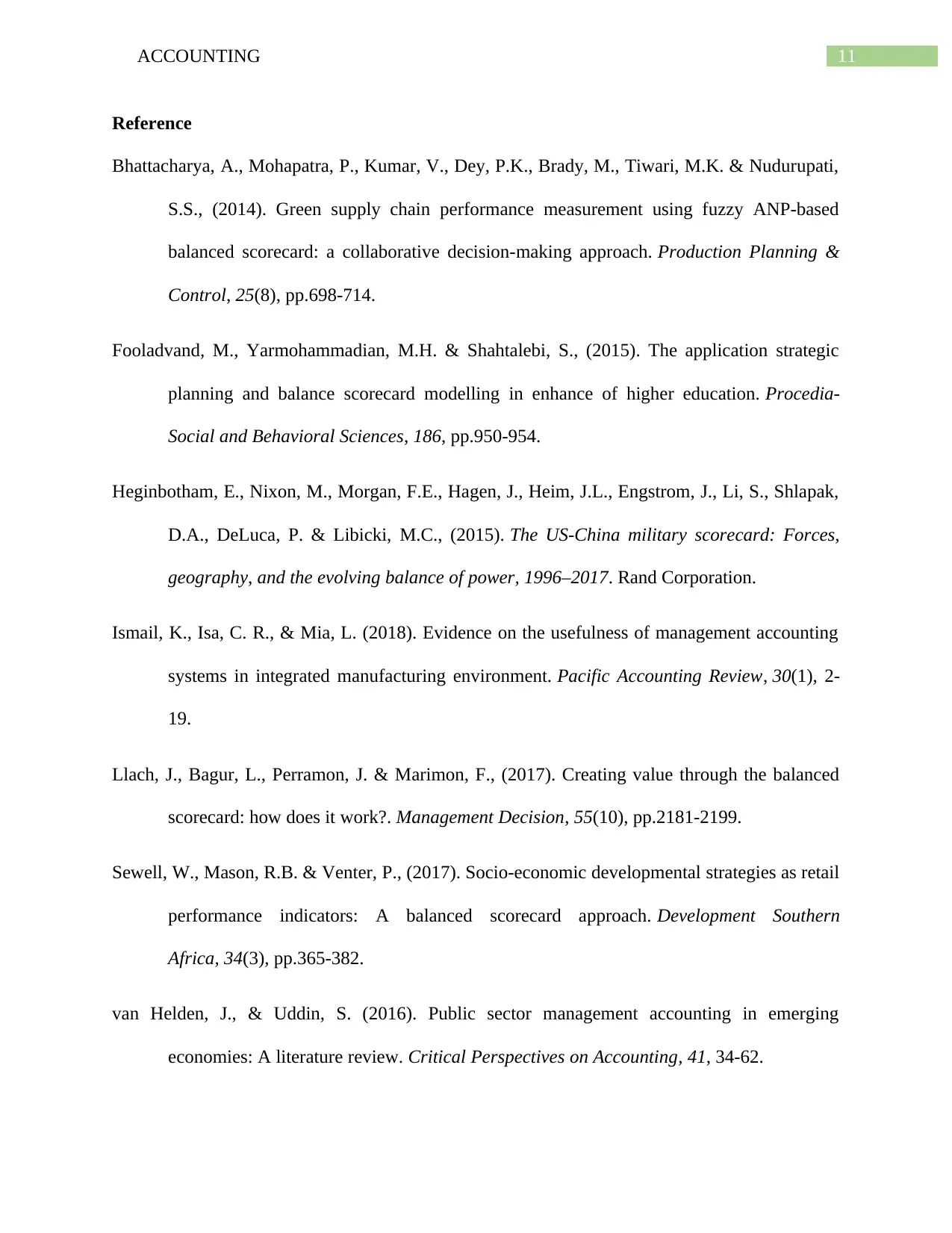
11ACCOUNTING
Reference
Bhattacharya, A., Mohapatra, P., Kumar, V., Dey, P.K., Brady, M., Tiwari, M.K. & Nudurupati,
S.S., (2014). Green supply chain performance measurement using fuzzy ANP-based
balanced scorecard: a collaborative decision-making approach. Production Planning &
Control, 25(8), pp.698-714.
Fooladvand, M., Yarmohammadian, M.H. & Shahtalebi, S., (2015). The application strategic
planning and balance scorecard modelling in enhance of higher education. Procedia-
Social and Behavioral Sciences, 186, pp.950-954.
Heginbotham, E., Nixon, M., Morgan, F.E., Hagen, J., Heim, J.L., Engstrom, J., Li, S., Shlapak,
D.A., DeLuca, P. & Libicki, M.C., (2015). The US-China military scorecard: Forces,
geography, and the evolving balance of power, 1996–2017. Rand Corporation.
Ismail, K., Isa, C. R., & Mia, L. (2018). Evidence on the usefulness of management accounting
systems in integrated manufacturing environment. Pacific Accounting Review, 30(1), 2-
19.
Llach, J., Bagur, L., Perramon, J. & Marimon, F., (2017). Creating value through the balanced
scorecard: how does it work?. Management Decision, 55(10), pp.2181-2199.
Sewell, W., Mason, R.B. & Venter, P., (2017). Socio-economic developmental strategies as retail
performance indicators: A balanced scorecard approach. Development Southern
Africa, 34(3), pp.365-382.
van Helden, J., & Uddin, S. (2016). Public sector management accounting in emerging
economies: A literature review. Critical Perspectives on Accounting, 41, 34-62.
Reference
Bhattacharya, A., Mohapatra, P., Kumar, V., Dey, P.K., Brady, M., Tiwari, M.K. & Nudurupati,
S.S., (2014). Green supply chain performance measurement using fuzzy ANP-based
balanced scorecard: a collaborative decision-making approach. Production Planning &
Control, 25(8), pp.698-714.
Fooladvand, M., Yarmohammadian, M.H. & Shahtalebi, S., (2015). The application strategic
planning and balance scorecard modelling in enhance of higher education. Procedia-
Social and Behavioral Sciences, 186, pp.950-954.
Heginbotham, E., Nixon, M., Morgan, F.E., Hagen, J., Heim, J.L., Engstrom, J., Li, S., Shlapak,
D.A., DeLuca, P. & Libicki, M.C., (2015). The US-China military scorecard: Forces,
geography, and the evolving balance of power, 1996–2017. Rand Corporation.
Ismail, K., Isa, C. R., & Mia, L. (2018). Evidence on the usefulness of management accounting
systems in integrated manufacturing environment. Pacific Accounting Review, 30(1), 2-
19.
Llach, J., Bagur, L., Perramon, J. & Marimon, F., (2017). Creating value through the balanced
scorecard: how does it work?. Management Decision, 55(10), pp.2181-2199.
Sewell, W., Mason, R.B. & Venter, P., (2017). Socio-economic developmental strategies as retail
performance indicators: A balanced scorecard approach. Development Southern
Africa, 34(3), pp.365-382.
van Helden, J., & Uddin, S. (2016). Public sector management accounting in emerging
economies: A literature review. Critical Perspectives on Accounting, 41, 34-62.
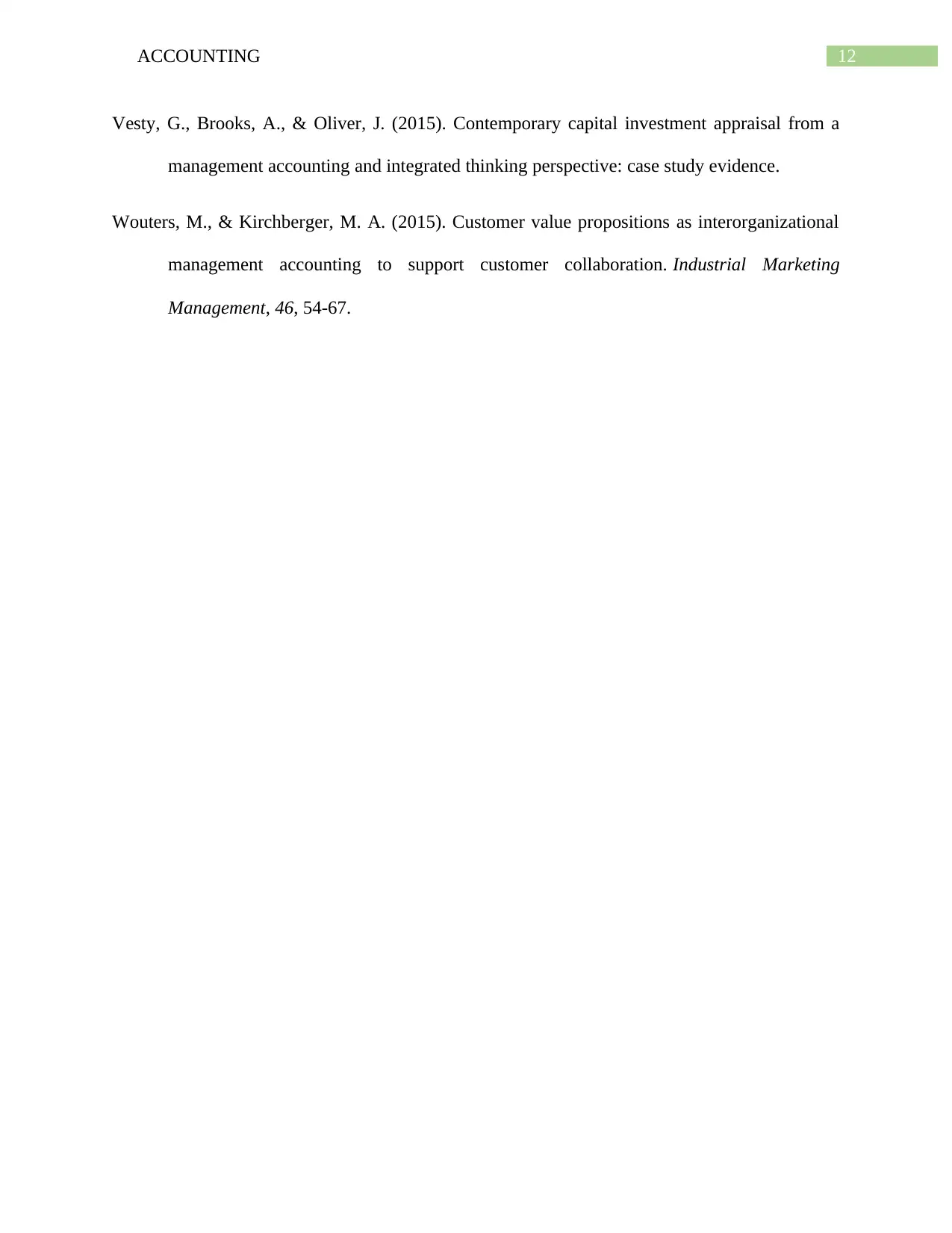
12ACCOUNTING
Vesty, G., Brooks, A., & Oliver, J. (2015). Contemporary capital investment appraisal from a
management accounting and integrated thinking perspective: case study evidence.
Wouters, M., & Kirchberger, M. A. (2015). Customer value propositions as interorganizational
management accounting to support customer collaboration. Industrial Marketing
Management, 46, 54-67.
Vesty, G., Brooks, A., & Oliver, J. (2015). Contemporary capital investment appraisal from a
management accounting and integrated thinking perspective: case study evidence.
Wouters, M., & Kirchberger, M. A. (2015). Customer value propositions as interorganizational
management accounting to support customer collaboration. Industrial Marketing
Management, 46, 54-67.
1 out of 13
Related Documents
Your All-in-One AI-Powered Toolkit for Academic Success.
+13062052269
info@desklib.com
Available 24*7 on WhatsApp / Email
![[object Object]](/_next/static/media/star-bottom.7253800d.svg)
Unlock your academic potential
© 2024 | Zucol Services PVT LTD | All rights reserved.




